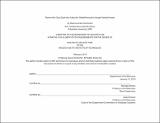Damn the city, dam the suburbs : redefining the single family home
Author(s)
Desmond, Marissa Grace
DownloadFull printable version (52.19Mb)
Alternative title
Redefining the single family home
Other Contributors
Massachusetts Institute of Technology. Dept. of Architecture.
Advisor
Michael Dennis.
Terms of use
Metadata
Show full item recordAbstract
Today, we no longer realize public perception of home ownership in the United States is primarily shaped by government sponsored programs. In the 1940's, however, it was these programs that created a change in the options for where to buy homes. What was previously the country became a place to live. Starting with the upper classes of society, white Americans began leaving the city for the suburbs. Buying a home, or investing in a future home through the purchase of war bonds, was a patriotic duty. With money from the GI Bill, developments like Levittown made it easy for Americans to invest in this government "propaganda." Much like the "white flight" of the 1940's, numerous upper class families are relocating to now up and coming neighborhoods within the city; the direction is reversed, the effect is the same. If we take it as a given that this gentrification of the city is the first step in the "white flight" of today, we can hypothesize that the rest of suburbia is bound to follow. This thesis proposes that community based housing projects, located in the inner towns surrounding cities, be recast as a new alternative to the suburban detached single family home. In light of the 2008 housing crash, numerous Americans are no longer able to afford their homes in either the suburbs or the city. With rents in the cities so high, and bound to go higher with the current demand, a two-bedroom apartment may be all some families can afford. However, two bedrooms in city are not an acceptable alternative to today's equally unaffordable suburban detached reality. Through the government sponsored programs of today and a focus on community living, a new housing type can emerge to re-house those displaced by today's housing crisis.
Description
Thesis (M. Arch.)--Massachusetts Institute of Technology, Dept. of Architecture, 2010. This electronic version was submitted by the student author. The certified thesis is available in the Institute Archives and Special Collections. "February 2010." Cataloged from student submitted PDF version of thesis. Includes bibliographical references (p. 158).
Date issued
2010Department
Massachusetts Institute of Technology. Department of ArchitecturePublisher
Massachusetts Institute of Technology
Keywords
Architecture.